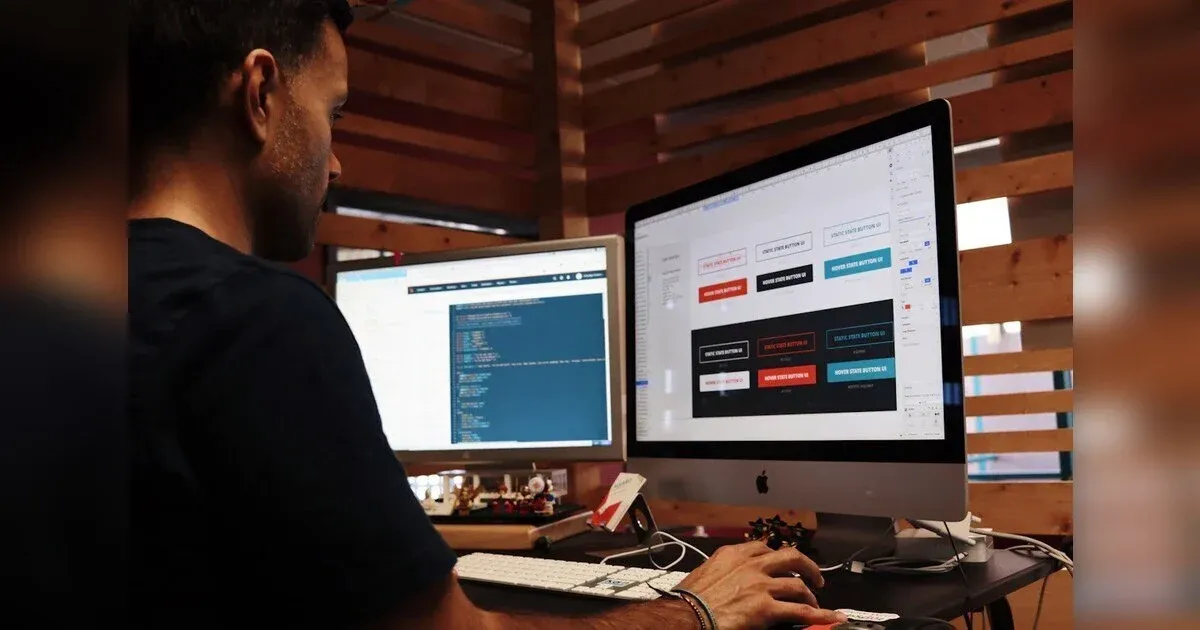Learn how to start out with AI as a UX Designer to enhance your work process.
You might be wondering if it's worth it or if it takes up a lot of time to learn how to use AI for UX. You might not fully understand how it functions, and that's completely reasonable! We understand - it is logical to seek answers to these questions before starting your journey of learning AI. We are here to assist in simplifying the start of your AI journey, from the advantages of utilizing AI for UX design to the tools and technical details needed.
What Advantages Does AI Bring To UX Design?
Using AI for UX design is important for multiple reasons. AI can assist in simplifying monotonous tasks, enabling individuals to focus on activities they enjoy and that have a significant influence. Instead of dedicating a significant amount of time to one task, you can quickly iterate using the assistance of artificial intelligence or fully automate tasks such as creating placeholder content and organizing research data.
Another important reason why UX designers should understand how to use AI is to develop a personalized experience for users who visit their websites. There are additional motives for designers to start their AI for UX design journey. Two main points are the chance to make data-driven decisions more efficient and to improve ease of use. By using AI, UX designers can effectively evaluate user feedback and data. They can even utilize it to combine sticky notes from workshops in Figjam, and transcripts from user interviews.
As a result of AI, designers are given the opportunity to make design choices that will be in accordance with or even better, surpass user expectations. Also, there is the element of usability. AI helps designers rapidly comprehend the main challenges users encounter during their experience. Afterward, designers can utilize those insights to make appropriate decisions for users. It also leads to enhanced productivity and superior quality.
Numerous research findings indicate that professionals in the business sector are able to complete tasks more quickly with the use of artificial intelligence (AI). For instance, AI helped designers at a prestigious design firm boost productivity by 35% and improve the quality of their deliverables by 40%. AI is a sidekick for UX professionals. It quickens the process and enhances our outcomes.
That will enable us to complete more UX work, although it does not eliminate the necessity for human evaluation. Then, last but not least, the collaboration of humans and AI results in superior quality compared to individual efforts. Therefore, artificial intelligence has the ability to enhance human abilities. UX design experts utilize artificial intelligence to rapidly generate placeholder text that serves as a starting point for developing stories in their designs.
The main motivation for any UX professional to study AI is that job loss will not be due to AI itself, but to someone who utilizes AI more effectively. Considering the significant improvements in performance achieved with AI, you have no hope of succeeding without it. This will become even more accurate in the future as AI technology advances. You can even utilize it for combining a vast quantity of information, such as user feedback in spreadsheets.
Another important reason why UX designers should understand how to use AI is to develop a personalized experience for users who visit their websites. There are additional motives for designers to start their AI for UX design journey. Two main points are the chance to make data-driven decisions more efficient and to improve ease of use. By using AI, UX designers can effectively evaluate user feedback and data. They can even utilize it to combine sticky notes from workshops in Figjam, and transcripts from user interviews.
As a result of AI, designers are given the opportunity to make design choices that will be in accordance with or even better, surpass user expectations. Also, there is the element of usability. AI helps designers rapidly comprehend the main challenges users encounter during their experience. Afterward, designers can utilize those insights to make appropriate decisions for users. It also leads to enhanced productivity and superior quality.
Numerous research findings indicate that professionals in the business sector are able to complete tasks more quickly with the use of artificial intelligence (AI). For instance, AI helped designers at a prestigious design firm boost productivity by 35% and improve the quality of their deliverables by 40%. AI is a sidekick for UX professionals. It quickens the process and enhances our outcomes.
That will enable us to complete more UX work, although it does not eliminate the necessity for human evaluation. Then, last but not least, the collaboration of humans and AI results in superior quality compared to individual efforts. Therefore, artificial intelligence has the ability to enhance human abilities. UX design experts utilize artificial intelligence to rapidly generate placeholder text that serves as a starting point for developing stories in their designs.
The main motivation for any UX professional to study AI is that job loss will not be due to AI itself, but to someone who utilizes AI more effectively. Considering the significant improvements in performance achieved with AI, you have no hope of succeeding without it. This will become even more accurate in the future as AI technology advances. You can even utilize it for combining a vast quantity of information, such as user feedback in spreadsheets.
AI Is Great For Seasoned UX Designers
Every UX expert should utilize AI as it is beneficial at all seniority levels and for various tasks throughout the UX process, such as research, design, and writing. Research indicates that most UX professionals are already utilizing it. However, including a significant amount of human judgment in the workflow is crucial for maximizing the benefits of AI due to crucial reasons.
Top Tips on Utilizing AI for UX Design
If you believe AI for UX design is valuable but don't know where to start, don't worry. We have written some useful tips that will guide you all through your journey. Given the various considerations, here are some suggestions to begin implementing AI for UX design:
- Start Small
This initial advice may be challenging, but once you conquer it, you're on the right track. Start small when you are still beginning with AI as a UX Designer. Although it may be difficult at first, don't feel intimidated when attempting it. Search for methods in which AI can assist in streamlining your workflow and automating certain tedious responsibilities, as opposed to initially tackling intricate, large-scale issues.
After gaining a deeper grasp of the tools' functionality, you can gradually explore how they can help with more extensive tasks in your work. However, to avoid feeling overwhelmed (and ultimately discouraged), it is essential to begin with small steps and gradually increase your understanding. Don't rush to learn everything as AI is constantly evolving.
If you want to fully dive into the AI world after learning the basics, think about signing up for a course and consider AI tools as a point of commencement. For instance, the field of UX is known for being filled with specialized language. AI bots such as ChatGPT are capable of educating individuals on various UX terms, techniques, and tools.
After gaining a deeper grasp of the tools' functionality, you can gradually explore how they can help with more extensive tasks in your work. However, to avoid feeling overwhelmed (and ultimately discouraged), it is essential to begin with small steps and gradually increase your understanding. Don't rush to learn everything as AI is constantly evolving.
If you want to fully dive into the AI world after learning the basics, think about signing up for a course and consider AI tools as a point of commencement. For instance, the field of UX is known for being filled with specialized language. AI bots such as ChatGPT are capable of educating individuals on various UX terms, techniques, and tools.
- Do Not Depend On It Completely
You should not depend on AI completely in your UX design career. You should try to gain additional knowledge about how to avoid depending on it entirely. You can collaborate with AI to enhance your work. Instead of seeing it as AI against humans, consider it as AI alongside humans. It is suggested that you only use it as a source of ideas.
The magic happens when you combine your own human ideas with AI outputs as your starting points. Relying solely on AI will lead to producing outcomes similar to those of others. Note that when you first attempt to interact with ChatGPT, it will generate a lot of irrelevant responses. After using the tool for some time, it will have a better grasp of your preferences and needs.
The magic happens when you combine your own human ideas with AI outputs as your starting points. Relying solely on AI will lead to producing outcomes similar to those of others. Note that when you first attempt to interact with ChatGPT, it will generate a lot of irrelevant responses. After using the tool for some time, it will have a better grasp of your preferences and needs.
- Request For References And URLs
At present, the majority of generative AI bots do not provide automatic citations for their sources, but you have the option to request them. Request links to those sources and verify the accuracy of the information given. Be cautious, the sources provided may be inaccurate or non-existent. ChatGPT can reference a non-existent person when asked for sources.
Determine Which Tools You Are Currently Using That Already Include AI
Many of the tools you are already familiar with may have added AI features that you can choose to utilize. One example is Content Hub, which includes built-in AI to help users create customized and captivating websites with less effort. Likewise, AI is probably integrated into other tools you are already acquainted with. You should explore AI improvements for apps that are familiar and special to you.
For example, we recently found out about the AI-powered sorting feature for sticky notes in Figjam, and it's been incredibly useful! You might discover a simpler, more efficient method to utilize your preferred tool. It will definitely benefit both parties. Request suggestions from your colleagues about AI-driven upgrades they are fond of to receive recommendations.
For example, we recently found out about the AI-powered sorting feature for sticky notes in Figjam, and it's been incredibly useful! You might discover a simpler, more efficient method to utilize your preferred tool. It will definitely benefit both parties. Request suggestions from your colleagues about AI-driven upgrades they are fond of to receive recommendations.
Top AI Tools for Enhancing UX Design
Which tools are available to use when starting your journey into AI for UX design? Numerous AI tools are currently available, with new ones being introduced to the market every week. However, initially, stick to the basics. We have a few recommendations to talk about.
1. Figma
If you are already using Figma, you will be pleased to know that this tool comes with integrated AI features. Since you are familiar with the platform, the learning process will be easier. FigJam can be utilized to enable your team to work together simultaneously, produce templates, and devise visual timelines with simple cues.
2. Uizard
Coming up next is Uizard, an additional AI-driven tool that will be beneficial for UX designers. Uizard is a very useful tool and it has an easy-to-use platform.
3. Galileo AI Technology
Also, there is Galileo AI, a platform for generating UI that simplifies the process of design ideation.
4. ChatGPT
ChatGPT is basically a tool for generating chat responses. Begin by using ChatGPT's complimentary version. Then, as you start utilizing AI more often, we highly suggest upgrading to the paid subscription for access to the latest version (currently v.4), which is far superior to the older, free version (v. 3.5). A ChatGPT subscription comes with the chatbot (currently the top text-generation AI tool) and the image-generation tool DALL-E 3, which is excellent but not quite on par with.
5. Midjourney
Midjourney is another great place to begin. If you work with visual design, we suggest subscribing to Midjourney for its variety of image-focused features and top-notch AI image-generation capabilities. However, the usability of the current Midjourney version is not really great. It is said to be difficult to learn, but there are rumors about a new and improved version coming soon.
Conclusion
Start exploring AI to improve your UX Design. You will gradually make great progress towards becoming an expert in AI. Don't forget that AI is constantly improving, so staying informed about new features and products is always a good idea. By doing that, you will discover numerous applications of AI in UX design.


























